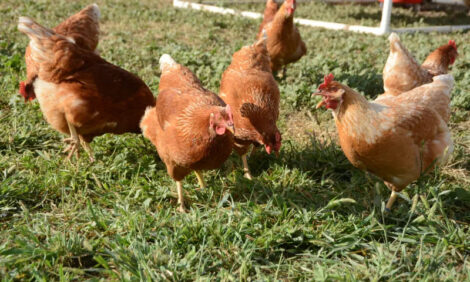



Role of Intestinal Pathology and Clostridial Species in Clostridial Dermatitis on US Turkey-Grower Farms
Intestinal damage may play a role in clostridial dermatitis in turkeys, according to a new USDA Animal and Plant Health Inspection Service (APHIS) study.Introduction
A disease of turkeys and broilers, clostridial dermatitis
(cellulitis/gangrenous dermatitis) has become an issue of
concern in recent years.
In 2010, the US Animal Health
Association (USAHA) ranked clostridial dermatitis
among the top three disease issues in turkeys (USAHA,
2010).
The disease causes mortality with subcutaneous
necrosis, oedema and/or emphysema, and most often
affects toms 13 to 18 weeks old (Clark, 2010). Disease
pathogenesis, however, is poorly understood. Clostridial
dermatitis is believed to be caused by haematogenous
transmission of clostridium from the gastrointestinal tract
to muscle and skin where bacterial toxins are produced.
There is uncertainty about whether pathology of the
intestine is required to allow clostridial organisms or their
toxins to enter the bloodstream.
Methodology
The US Department of Agriculture's National
Animal Health Monitoring System (NAHMS) conducted a
study to investigate intestinal pathology and the
presence of clostridial organisms on US turkey farms.
The goal of the study was to better understand the role
of intestinal pathology and clostridial species in the
pathogenesis of clostridial dermatitis.
For the study, 15 of the nation's largest turkey
companies were selected to participate. The selected
companies represented 76.8 per cent of turkeys
slaughtered in the United States in 2009 (Watt, 2010).
Seven of the selected companies collected biologic
samples from 25 farms — 19 case farms and six control
farms.
Participating companies selected case and control
farms based on the following criteria:
- case farm — a farm with a history of frequent clostridial dermatitis outbreaks and on which an outbreak was anticipated during the year;
- control farm — a farm on which a clostridial dermatitis outbreak was not anticipated.
Case farms were visited weekly during the time
leading up to an anticipated outbreak. Control farms
were visited weekly during the same time period.
Anticipated timing of an outbreak was based on the
farm's previous history. Of the 19 case farms, 16 had an
outbreak of clostridial dermatitis during the study. Three case farms and all six control farms did not have an
outbreak during the study.
Samples were collected from 397 birds between 27 May and 16 October 2010. Three birds per week were
euthanised, and intestinal samples were collected for
anaerobic culture and histopathology. Samples of liver,
litter, and litter beetles (if present) were also collected
weekly for anaerobic culture. Poultry litter samples were
taken from three locations in the poultry barns (the
middle of the barn, under the feeder, and away from the
feeder/drinkers) and then pooled. On the final visit,
additional samples collected for culture included spleen
and muscle from three euthanized birds.
During clostridial dermatitis outbreaks, spleen, liver
and muscle/subcutaneous samples were collected from
recent mortalities with lesions but intestinal culture and
histopathology were not performed on birds found dead.
See the NAHMS report 'Poultry 2010: Clostridial
Dermatitis on US Turkey-Grower Farms' for details on
the types of samples collected (USDA, 2012).
Histopathology was conducted at North Carolina State
University and anaerobic culture was conducted at Iowa
State University.
The Role of Clostridium septicum in Clostridial Dermatitis
Both Clostridium septicum and Clostridium
perfringens have been suggested as causative agents
for clostridial dermatitis, but C. septicum may be the
principal cause (Tellez, 2009).
Findings from this NAHMS study support the theory
that C. septicum is the primary clostridial organism
involved in clostridial dermatitis outbreaks. During
outbreaks, 42 per cent of sampled birds were positive for
C. septicum (i.e., had C. septicum cultured from one or
more tissues). In comparison, only 1 percent of birds
from non-outbreak farms were positive for C. septicum.
Similarly, in the weeks preceding an outbreak on
outbreak farms, only one per cent of birds were positive for
C. septicum (Figure 1). These findings suggest that
C. septicum prevalence increases acutely at the time of
an outbreak, as opposed to a high percentage of birds
chronically harbouring the organism on affected farms.
Figure 1. Percentage of birds positive for C. septicum and C. perfringens,
by farm outbreak status

Approximately 20 percent of birds were positive for
C. perfringens on outbreak and non-outbreak farms,
regardless of the presence or absence of a clostridial
dermatitis outbreak (figure. 1). From this study, it is
unclear what role, if any, C. perfringens plays in
clostridial dermatitis.
Positive culture results from liver and spleen
samples also provided evidence to support the theory of
haematogenous spread of C. septicum. In fact, 21 percent
of the birds sampled during an outbreak of clostridial
dermatitis had C. septicum in the liver, and 18 percent
had it in the spleen; 48 percent of birds sampled had
C. septicum in the muscle/subcutaneous tissue (table 1).
Of birds euthanised for sampling during an outbreak, 29
percent had C. septicum in the muscle/subcutaneous
tissues (table 1), but most of these birds did not have
gross clostridial dermatitis lesions. Interestingly, no birds
had C. septicum cultured from the intestines during
outbreaks (Table 1). However, the presence of
C. septicum in the liver and spleen still suggests
intestines as a likely source of the organism. On
outbreak farms in the weeks prior to an outbreak,
C. septicum was found in only one intestinal sample and
in one liver sample (data not shown).
| Table 1. Percentage of birds positive for C. septicum during a clostridial dermatitis outbreak, by tissue tested and by bird type | ||||||
|---|---|---|---|---|---|---|
| Percent Birds | ||||||
| Bird Type | ||||||
| Tissue | Euthanised birds | Recent dead with lesions | All birds | |||
| n | % | n | % | n | % | |
| GI | 0/48 | 0 | NA | 0/48 | 0 | |
| Liver | 2/48 | 4 | 15/34 | 44 | 17/82 | 21 |
| Spleen | 1/41 | 2 | 12/33 | 36 | 13/74 | 18 |
| Muscle | 9/31 | 29 | 22/33 | 67 | 31/64 | 48 |
| Any | 12/48 | 25 | 24/37 | 65 | 36/85 | 42 |
| NA= intestine not cultured in birds found dead. | ||||||
C. septicum in Poultry Litter and Litter Beetles
Very few litter or litter beetle samples were positive for C. septicum or C. perfringens; in fact, only one litter sample from an outbreak farm was positive for C. septicum (Table 2). This finding was surprising, since litter from flocks with clostridial dermatitis is theorized to contain high numbers of clostridial organisms (Clark, 2010). While litter may contain other species of Clostridium, it does not appear that C. septicum is present in high numbers in litter, although it might be that C. septicum is difficult to recover from litter. This study did not purposefully collect samples from areas where mortalities were removed or where litter was wet, when collecting samples. Litter from these areas might contain higher numbers of clostridial organisms.
| Table 2. Number of litter and litter beetle samples positive for C. septicum and C. perfringens, by farm type | ||
|---|---|---|
| Number Samples Positive | ||
| Farm Type | ||
| Sample type | Non-outbreak | Outbreak |
| Litter | ||
| C. septicum | 0/46 | 1/71 |
| C. perfringens | 0/46 | 1/71 |
| Litter beetles | ||
| C. septicum | 0/22 | 0/24 |
| C. perfringens | 2/22 | 0/24 |
The Role of Intestinal Pathology in Clostridial Dermatitis
Culture results support the theory of haematogenous
spread of clostridial organisms from the intestinal tract;
therefore, it is important to understand why or how
clostridia get into the bloodstream. Studying the role of
intestinal pathology in field outbreaks of clostridial
dermatitis is inherently challenging. Ideally, the
researcher would collect intestinal samples from birds
that are about to break with the disease, to see if
intestinal pathology is present before disease onset.
However, this is not possible, since intestinal sampling is
invasive and the onset of disease in an individual bird
cannot be predicted.
This study attempted to measure the role of
intestinal pathology by sampling random birds in the
weeks leading up to a clostridial dermatitis outbreak. To
see if intestinal changes were occurring in the flock,
intestinal pathology was assessed microscopically by
assigning lesion scores to four areas of the duodenum,
four areas of the ileum, and four areas of the caecum. A
single lesion score was assigned to Meckel's
diverticulum. The presence of luminal bacteria, coccidia,
and other parasites was also noted.
Intestinal pathology was common. Over half of all
sampled birds had at least mild pathology in the ileum,
and about 40 percent of birds had pathology in Meckel's
diverticulum. Ileal pathology was most commonly found
in the lamina propria or muscularis. A pattern of
increasing intestinal pathology in the weeks leading up
to an outbreak was not identified. In addition, the
percentages of birds with intestinal pathology were
similar on outbreak and non-outbreak farms (Figure 2).
Figure 2. Percentage of birds that had pathology in the following areas of the intestines, by farm outbreak status

Summary
The NAHMS study provided evidence to support two theories about the pathogenesis of clostridial dermatitis:
- C. septicum appears to be important in the pathogenesis of clostridial dermatitis.
- Haematogenous spread of C. septicum occurs on turkey-grower farms during clostridial dermatitis outbreaks.
C. septicum levels increased acutely at the time of
an outbreak, as opposed to birds chronically harbouring
the organism on affected farms. Surprisingly, very few
poultry litter or litter beetle samples were culture-positive
for C. septicum or C. perfringens.
Over half of turkeys on grower farms had some
degree of intestinal damage. Therefore, clostridia may
have the opportunity to enter the bloodstream in a high
percentage of birds. Although the study results did not
clearly define the role of intestinal pathology, intestinal
damage may play a role in clostridial dermatitis.
Further research is needed to better understand the
complex set of circumstances that culminate in this
disease.
References
Clark S., Porter R., McComb B., Lippert R., Olson S., Nohner S. and Shivaprasad H.L. 2010. Clostridial dermatitis and cellulitis: an emerging disease of turkeys. Avian Dis., 54(2):788–794.
Tellez G., Pumford N.R., Morgan M.J., Wolfenden A.D. and Hargis B.M. 2009. Evidence for Clostridium septicum as
a primary cause of cellulitis in commercial turkeys. J. Vet. Diagn. Invest., 21:374–377.
Further ReadingYou can view the previous article on the Poultry 2010 study by NAHMS by clicking here.For more information on gangrenous dermatitis / necrotic dermatitis, click here. |
October 2012








